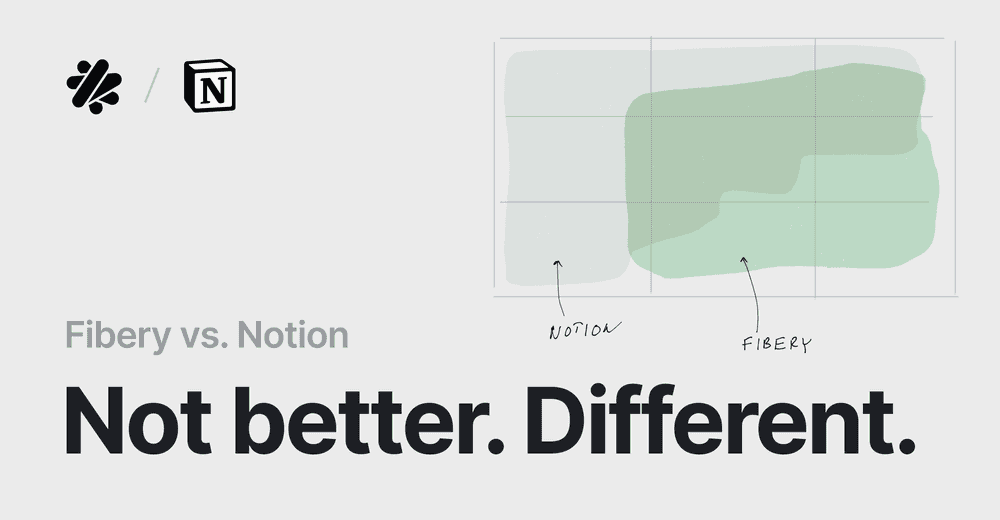Fibery vs. Monday. Complex vs. Simple Processes.
Usually, posts X vs. Y are shallow. This post is not. As the Fibery CEO, I have to switch off the bias. Take this post with a grain of salt.
The major goal is to explain how Fibery is different and what strengths and weaknesses it has. Monday is a very feature-rich product. However, it’s quite complicated. Let’s dig something interesting together.

General feelings
Monday is very similar to ClickUp in many ways, but it seems that Monday is slightly less feature-reach (surprisingly).
UI is high-contrast and snappy, but very flickery. When you move the mouse, everything blinks and changes, and this is quite distracting. It is visible that some parts of the system are new, while others are old, so the general feelings about the user interface are mixed. I can’t say that I like it, but I feel that I can get used to it with time.
The first 30 minutes are hard, but if you overcome the initial resistance, then the system starts to make sense.
Philosophy
Monday = Work OS
monday.com is a Work Operating System (Work OS) that powers teams to run projects and workflows with confidence.
Monday is a platform to build your processes. In this regard, the main mission is very similar to Fibery. Flexibility is the most important feature here.
Monday has all important building blocks to organize processes: Flexible databases, Views, integrations, rules, and many productivity features.
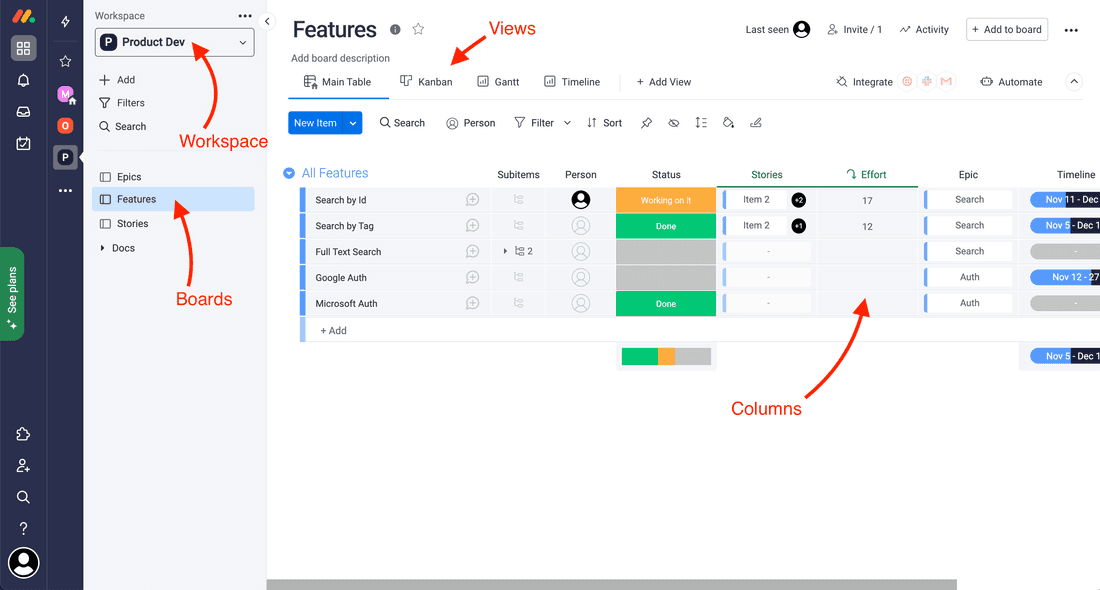
🦐 One serious problem is that you can’t model hierarchies and processes in a nice way. It’s not possible to have a tree view that shows Epics and Features. It’s not possible to have a board that shows Features by Epics, etc. Connections and relations are not a strong part of Monday. For complex processes, you will have to live with many workarounds.
Fibery = Set of connected Spaces
In Fibery everything is connected. The main building blocks are Space, Database, Relation, and View. Here is an example of a connected workspace for product development.
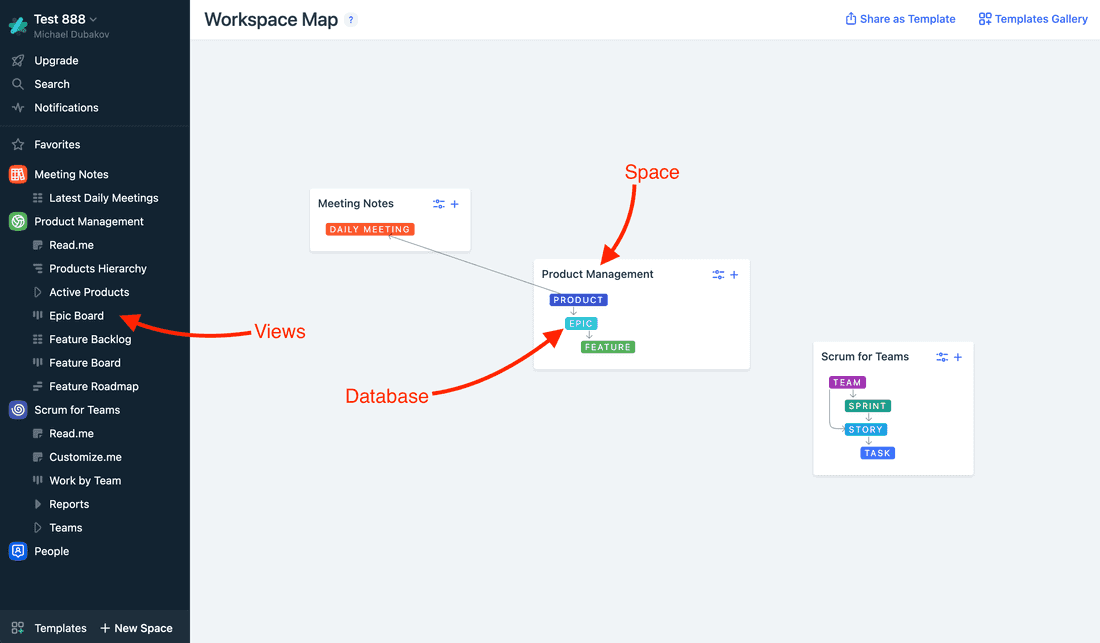
Note that Databases can represent hierarchy (Epic → Feature) and such structures are more natural to work with than just Tasks. Adding a new Epic? Add an Epic. Adding a new Candidate? Add a Candidate. Fibery represents your team terminology and adapts to your process.
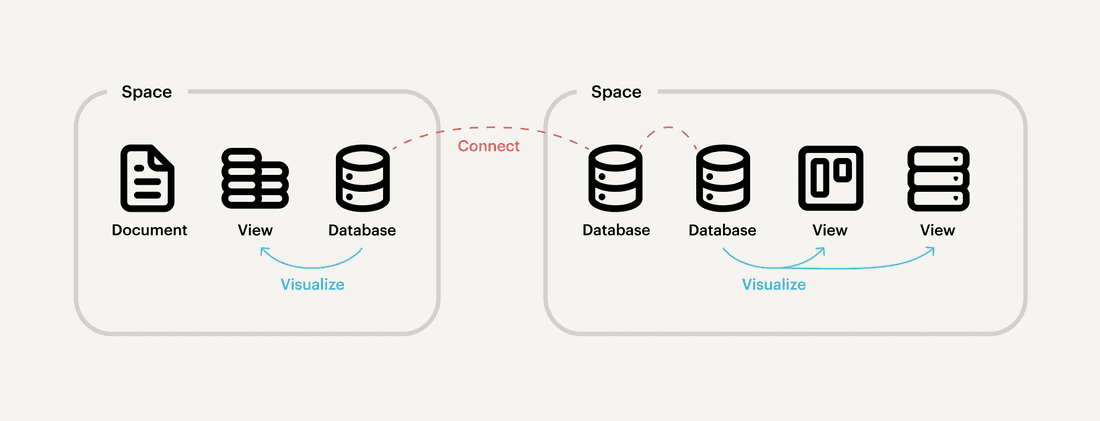
Translation sheet (as close as it can get)
Monday — Fibery
Account — Workspace
Workspace - Space
Board — Database
Item — Entity
Column — Field
View — ViewLet’s create a space
We’ll try to create a basic process in both tools. Let’s take a simple Product Management process with Epics and Features. Epics are huge requirements that break down into smaller requirements (Features).
Our main cases here are:
- Create hierarchical product backlog
- Write features specifications
- Create product roadmap
- Split features to user stories and track execution
In Monday I created a Product Management Workspace and two Boards for Epics and Features. Epics and Features are connected via a relation, so you can link several Features to an Epic.
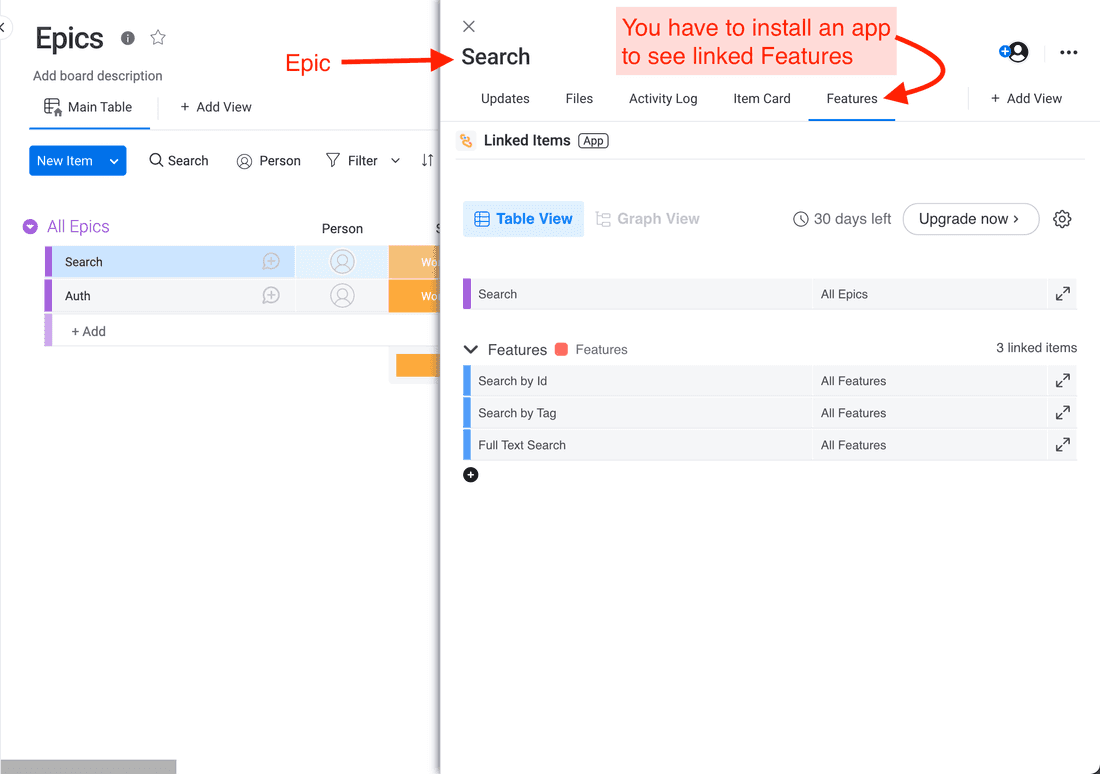
🦐 Unfortunately, relations in Monday are basic. You can’t use them as lanes on boards, as groups in lists, access in filters and formulas. It’s not possible to have a hierarchical backlog and you will have to manage Epics and Features from different Views.
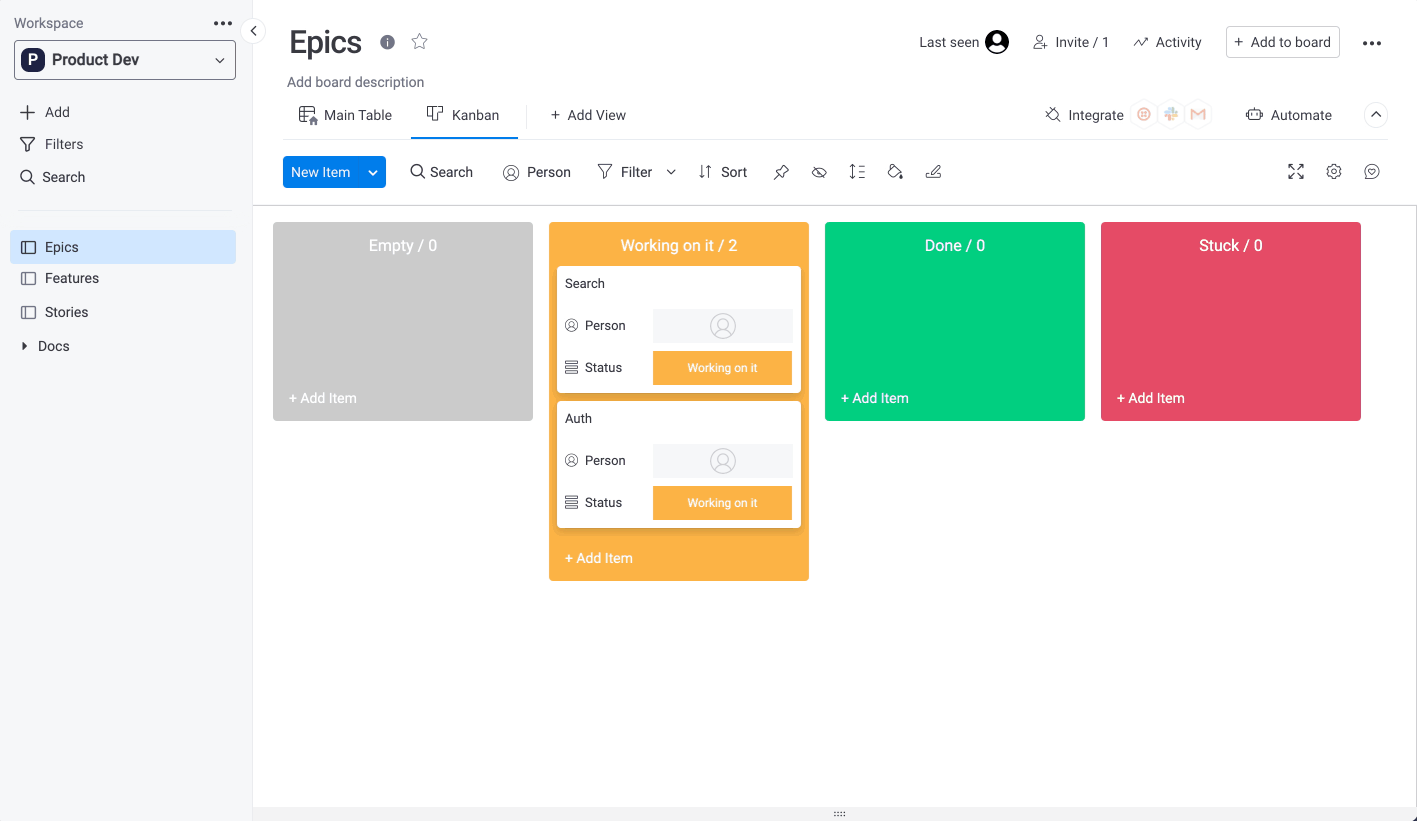
Monday. Navigating all views in Product Management Workspace.
In Fibery setup is as easy as in Monday. You just add new Databases, connect them via relation and create several Views to see all relevant information:
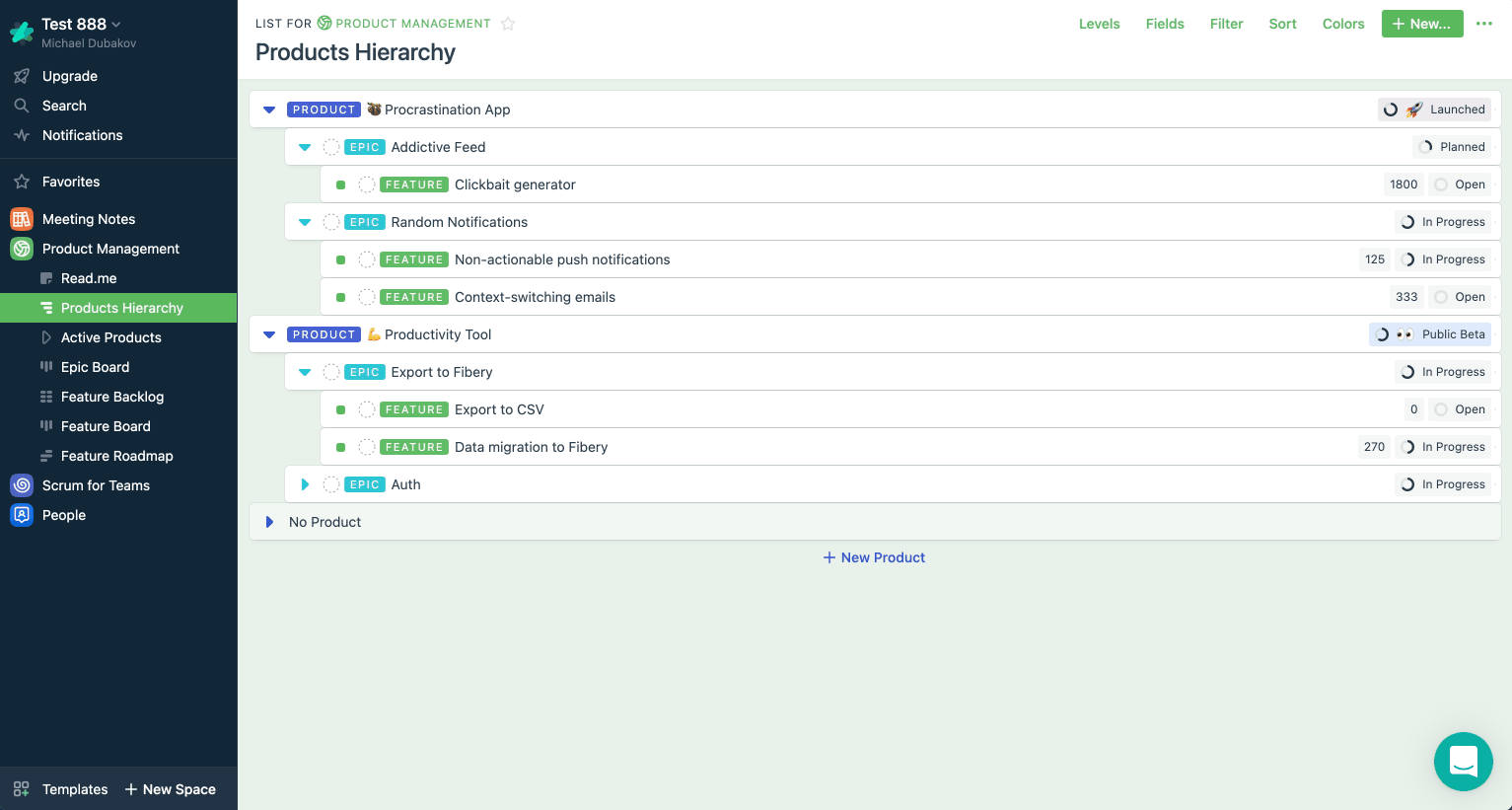
Fibery. Navigating all views in Product Management Space.
Note that in Fibery there are no restrictions with relations, so you can create a hierarchical backlog, group features by epics when required, and connect things better.
Create hierarchical product backlog
🦐 In Monday hierarchies are hard. You can’t quickly create Epic and its Features. You have to add an Epic, open the Epic, and add Features from there. It is very slow:
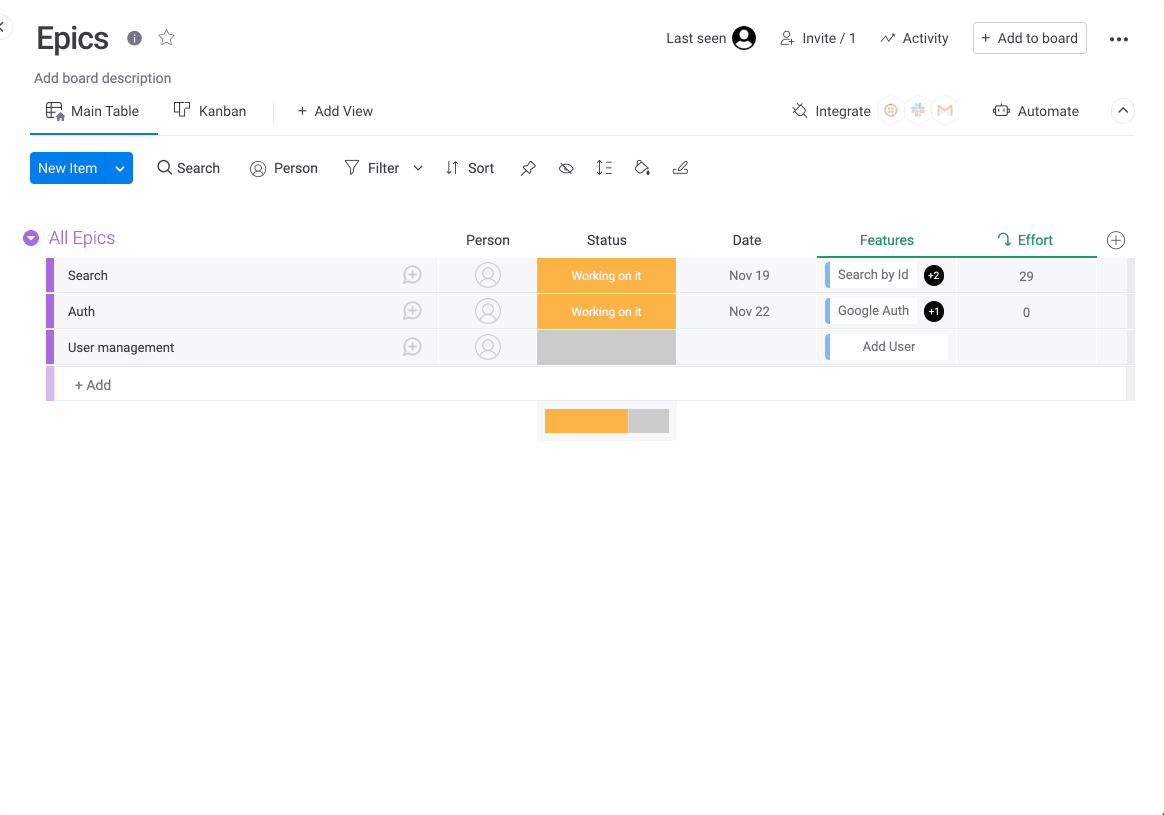
Adding an Epic and two Features in Monday.
💪 In Fibery hierarchies are easy. You can add Epics and Features from a single View:
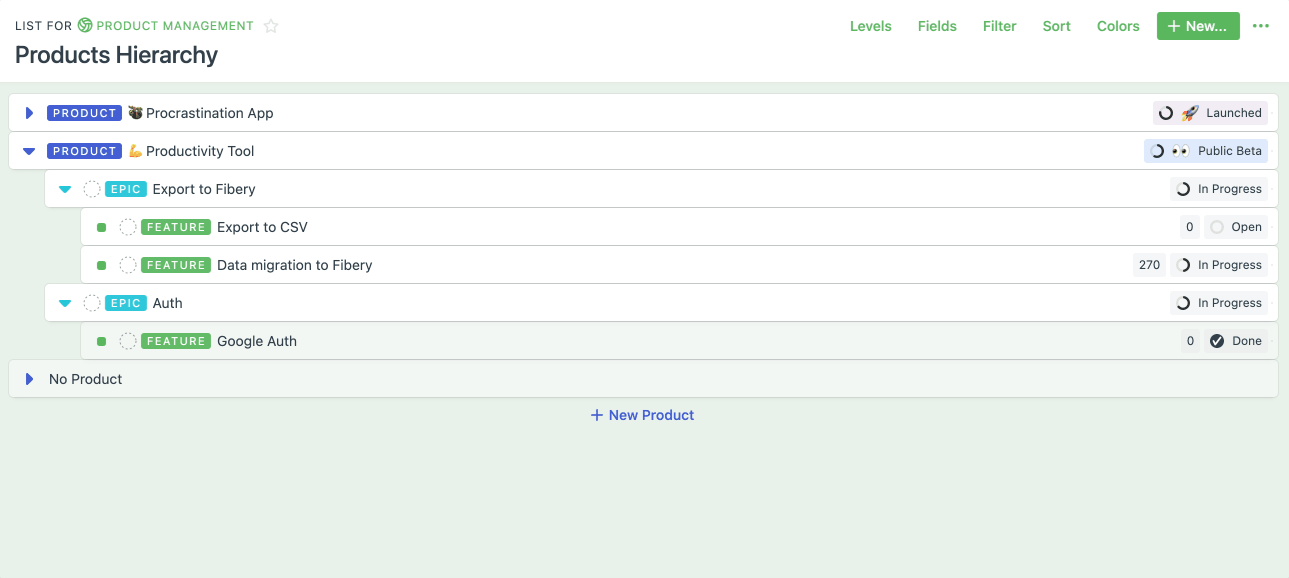
Adding an Epic and several Features in Fibery.
Epics/Features specification
Now I want to create a specification for an Epic. Usually, it’s just a document with some images.
🦐 Monday has just a text field for an Epic, so you will have to store Epics and Features specifications somewhere else. Unfortunately, this is the best what you can get with a text field…

It is not possible to embed documents into Monday entities.
💪 In Fibery there is a full-blown collaborative text editor so you can write decent specifications right here, without losing context.
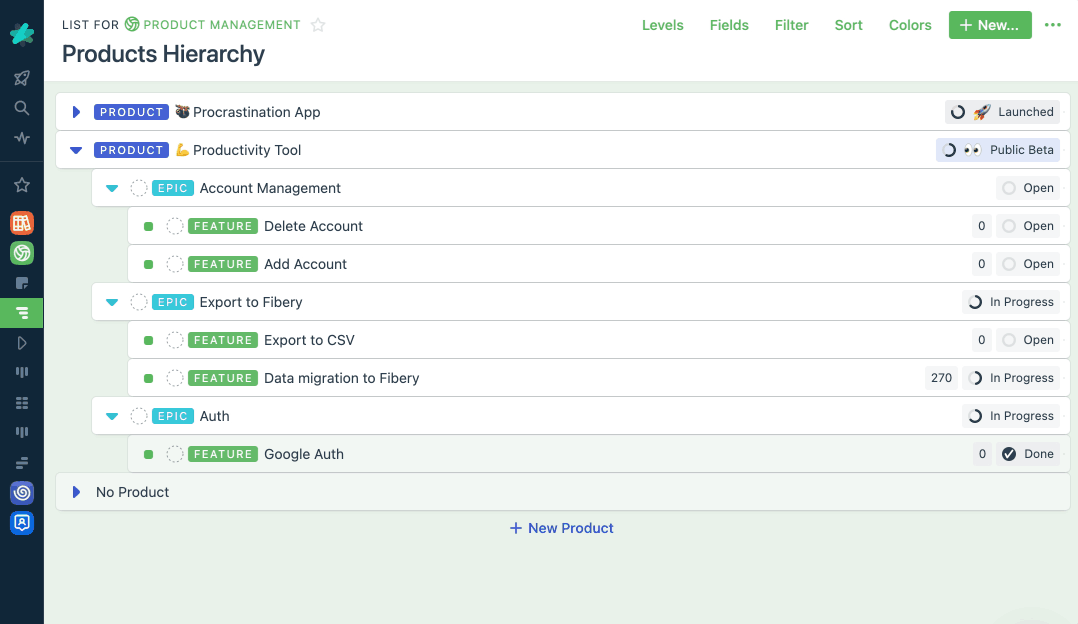
In Fibery there is a full-blown collaborative text editor so you can write decent specifications.
Create product roadmap
In Monday Roadmap View is limited, you can’t put existing Features on a roadmap and have to go to some other view to set Dates. You can add new Features and change Dates for existing Features.
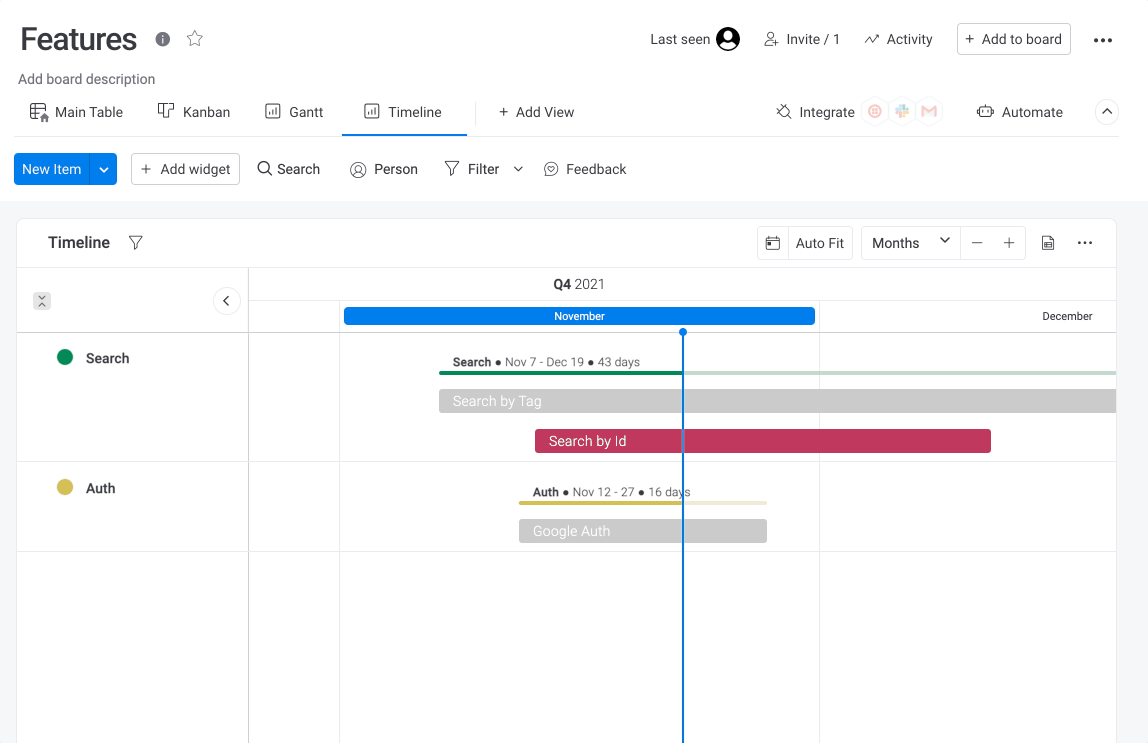
💪 In Fibery Timeline View is more robust. You can add existing Features, create new Features right on a Timeline, and even change Epics via drag and drop right here.
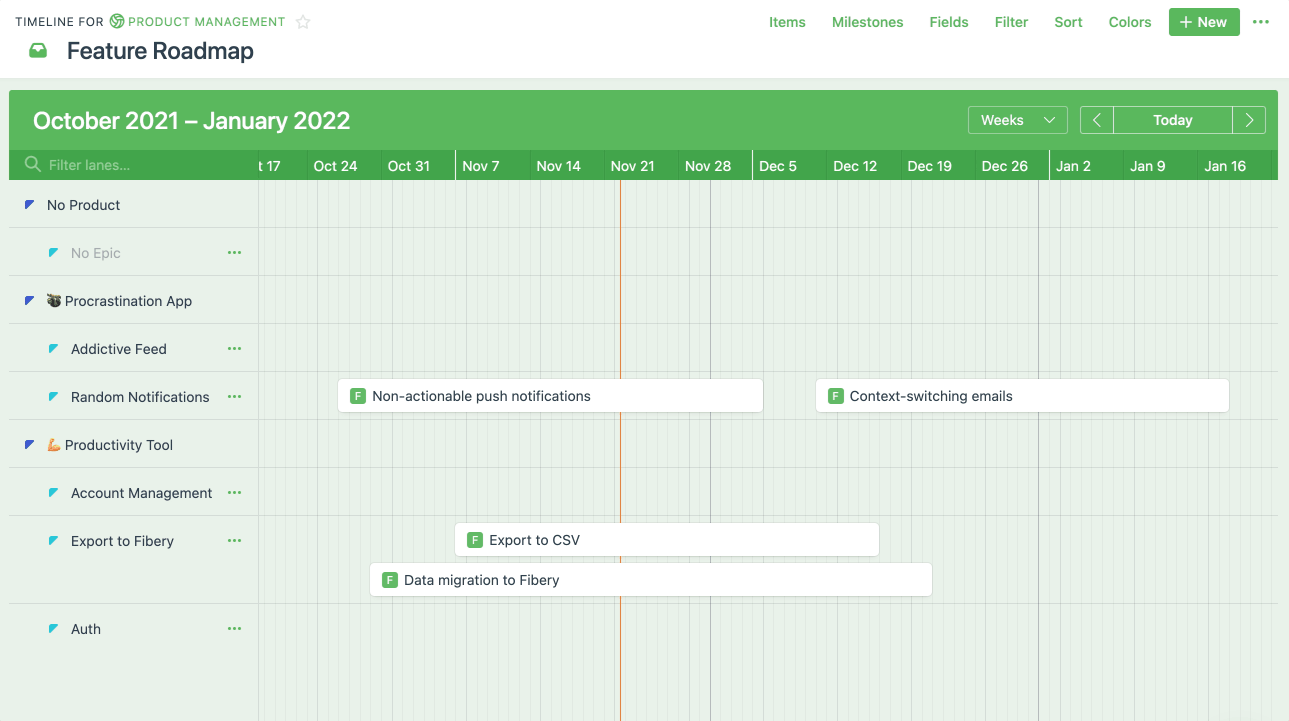
Monday is very flexible, but as you see, it does not work well for product management cases.
Building Blocks
Monday is a platform, let’s review all building blocks.
Information organization
In Monday you have Workspaces and Boards to organize information (Workspace → Board). This structure is generic and quite flexible since you can assign permissions to Workspace and Board. You can even restrict access to specific Columns for a Board.
Hierarchies are hard to create and visualize in Monday. While relations are there, it is not possible to visualize them in a good way.
In Fibery you have Spaces and Databases. Databases can form hierarchies, so you may have Department → Team → Features structure just from Databases.
Fibery has bi-directional links in text, so you can connect things more flexibly and help people discover unexpected connections.
Overall, Monday has decent mechanisms to organize information, but they’re slightly more limited than in Fibery.
Fields
Fields in Monday are vast. There is even a screen called Columns center!
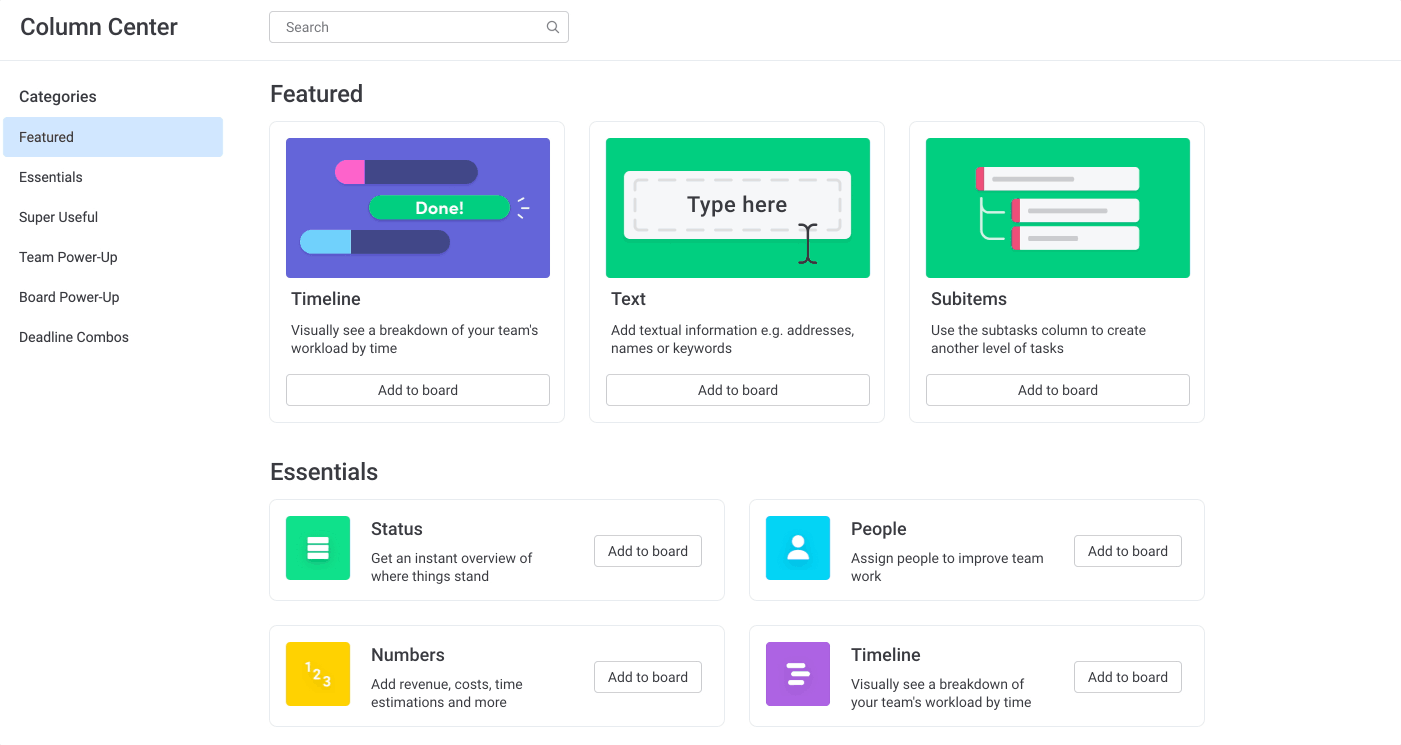
Every imaginable field is there in Monday
Fibery has no Location, Vote, Rating, Auto Number, and Color Picker fields.
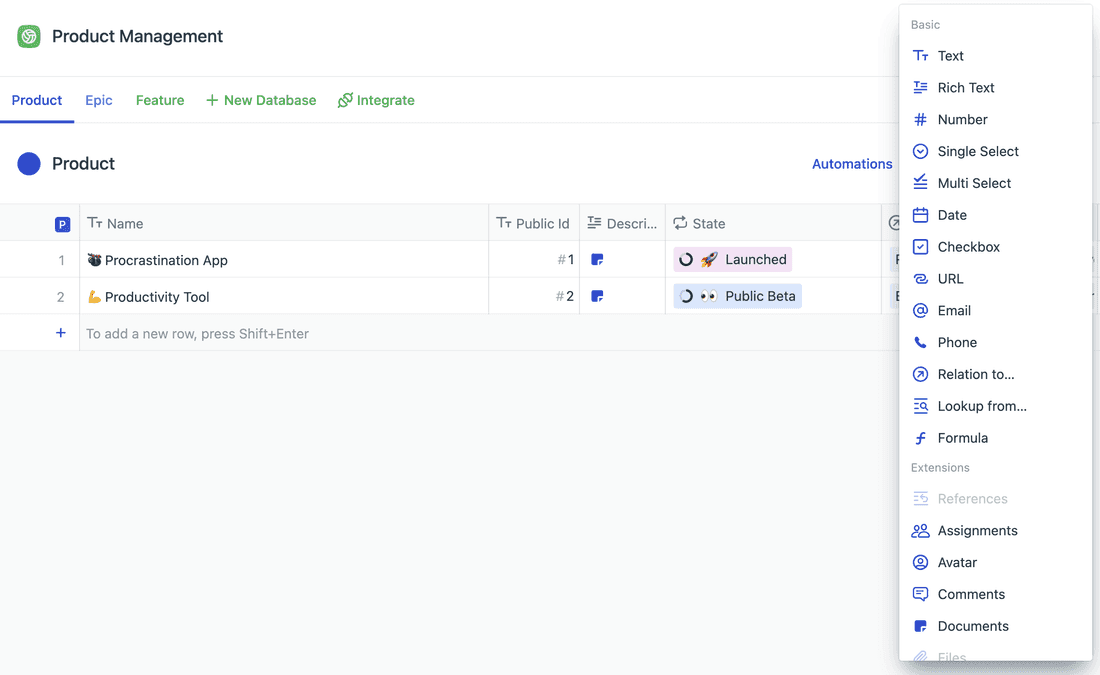
Relations
🦐 Relations in Monday are better than in most other tools but still worse than in Fibery. You can create relations by connecting two Boards:
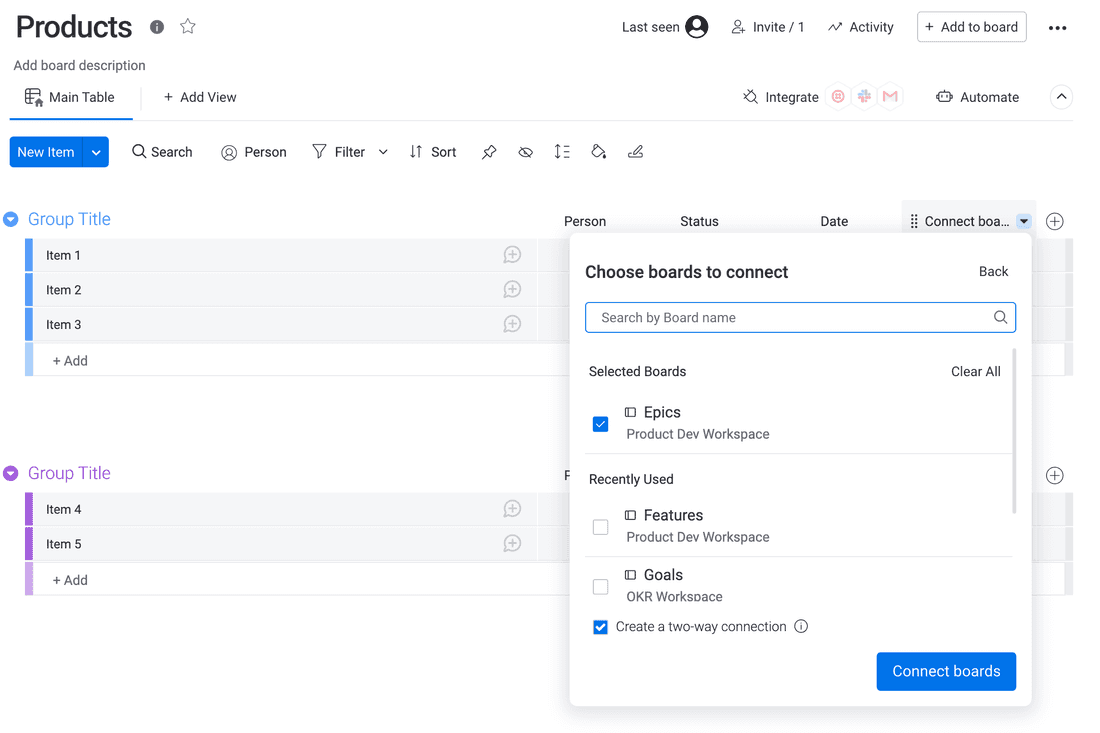
However, it’s very hard to work with relations in Monday. You can’t visualize them in a good way, linked collections are hard to see and modify, etc. On the positive side, you can use Formulas to calculate roll-ups and other things, but formula language is also limited.
Mirror columns help somewhat, but they look like a workaround for relation-specific problems.
Text-based bi-directional links are not there as well.
💪 In Fibery relations are first-class citizens. You can create complex structures and use relations to visualize information, calculate formulas, build charts, etc.
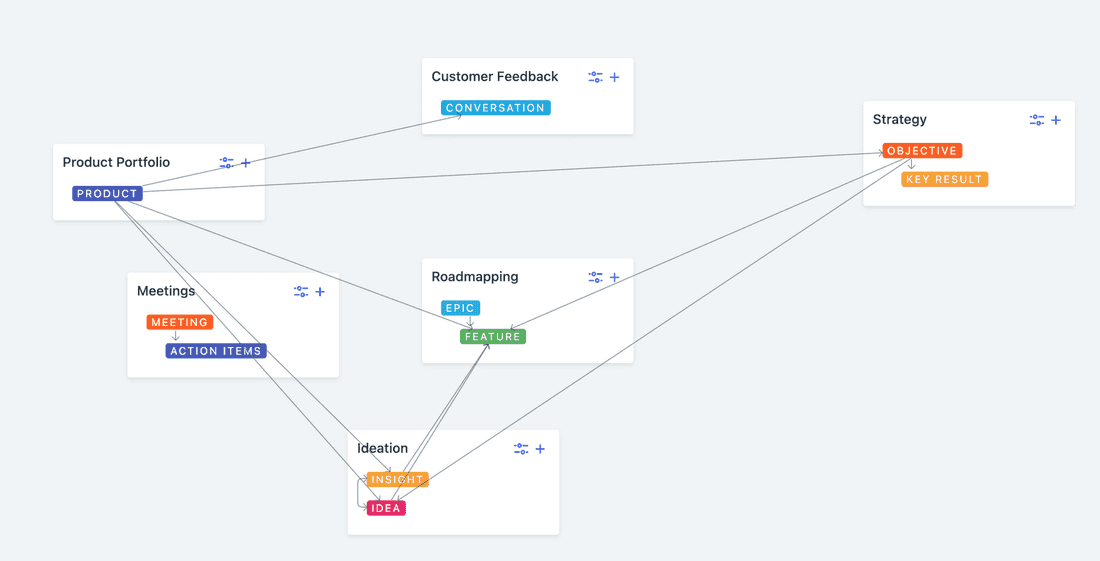
Bi-directional links are there. You can highlight any text and link it to any entity, thus adding a context to the link and helping generate insights:
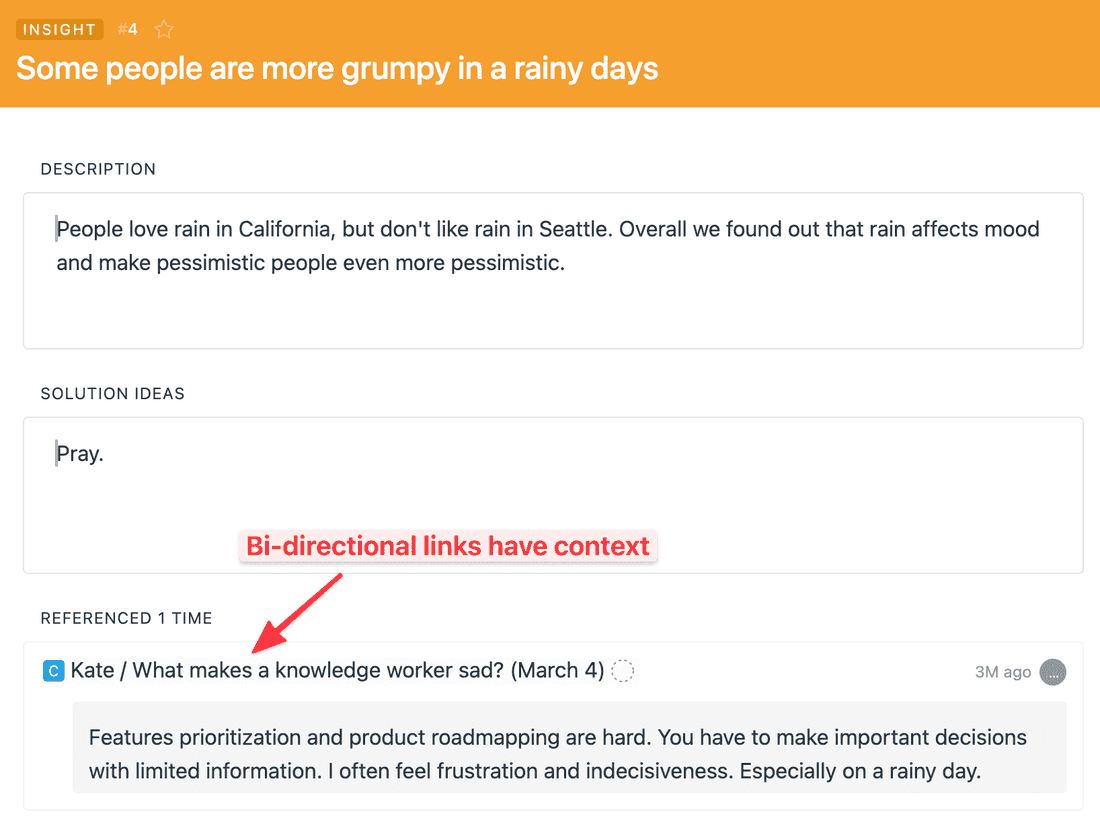
Formulas
In Monday formulas are quite powerful, but you can only use fields from a single Board (in general). You can do some hierarchical calculations, but only aggregates without filters. For example, if you want to see how much effort is remaining in an Epic for all open Features, it is not possible to do, but you can create a formula that shows you the total effort of all Features in an Epic.
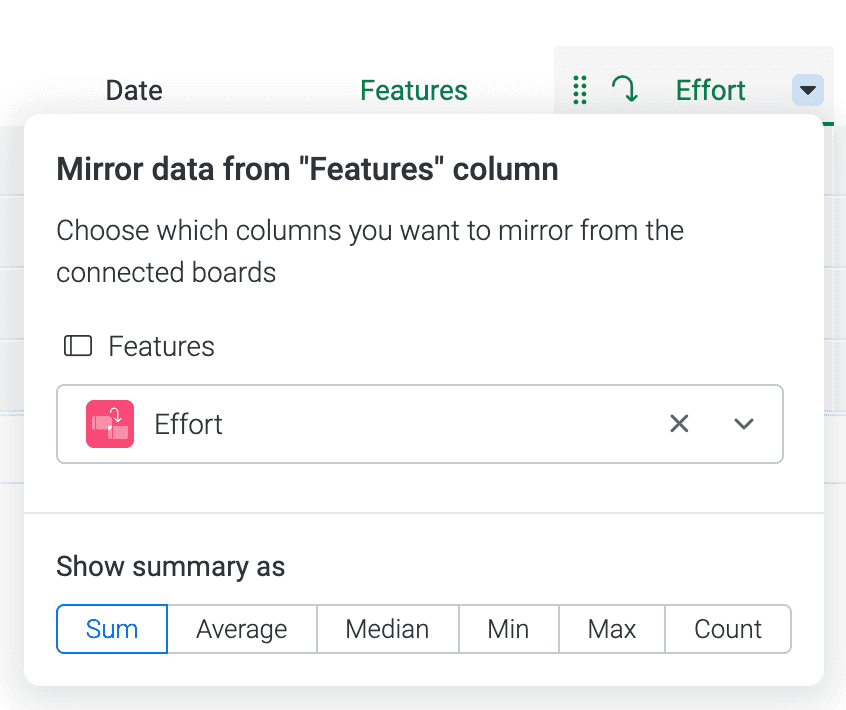
💪 In Fibery formulas work across the whole hierarchy, so you can access fields of related entities, calculate values of collections, etc. For example, you can calculate the sum of Effort of all not completed Features:
Features.Filter(State.Final != true).Sum(Effort)
Views
Monday has many views. Here is the full list: Dashboard, Chart, Gantt, Calendar, Workload, Timeline, Table, Kanban, Form, Card.
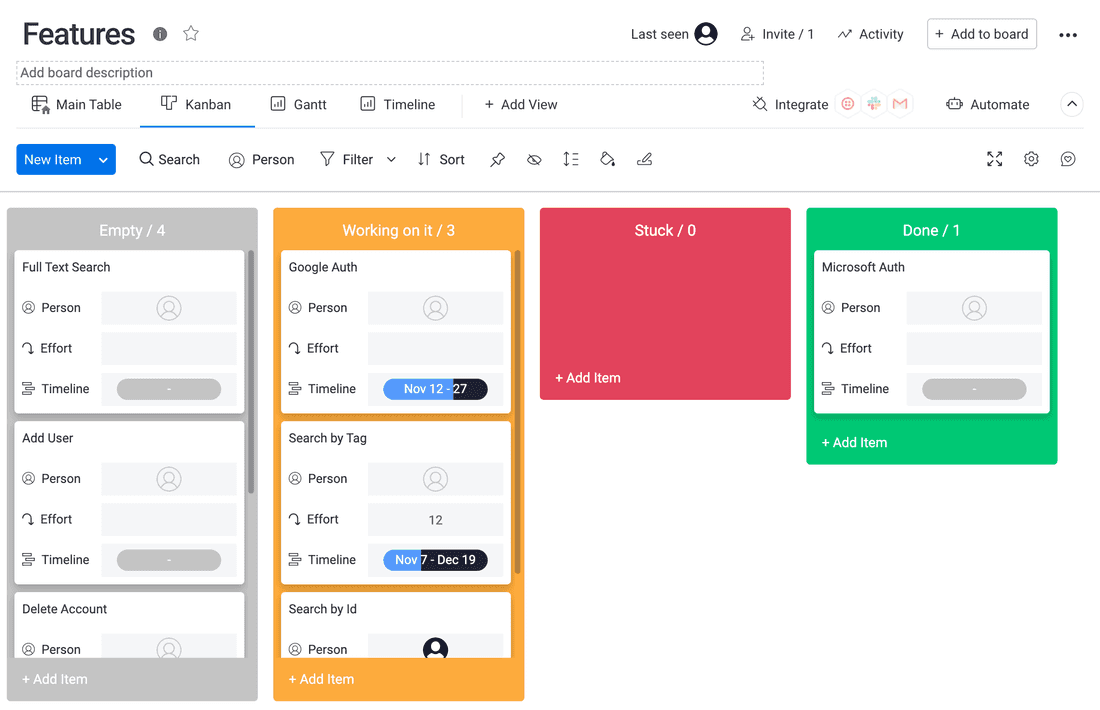
Fibery has slightly fewer views: List, Board, Calendar, Timeline, Whiteboard, Table, Form. Some views are more powerful. For example, a List can represent deep hierarchies, Board can have horizontal lanes, Timeline is more interactive.
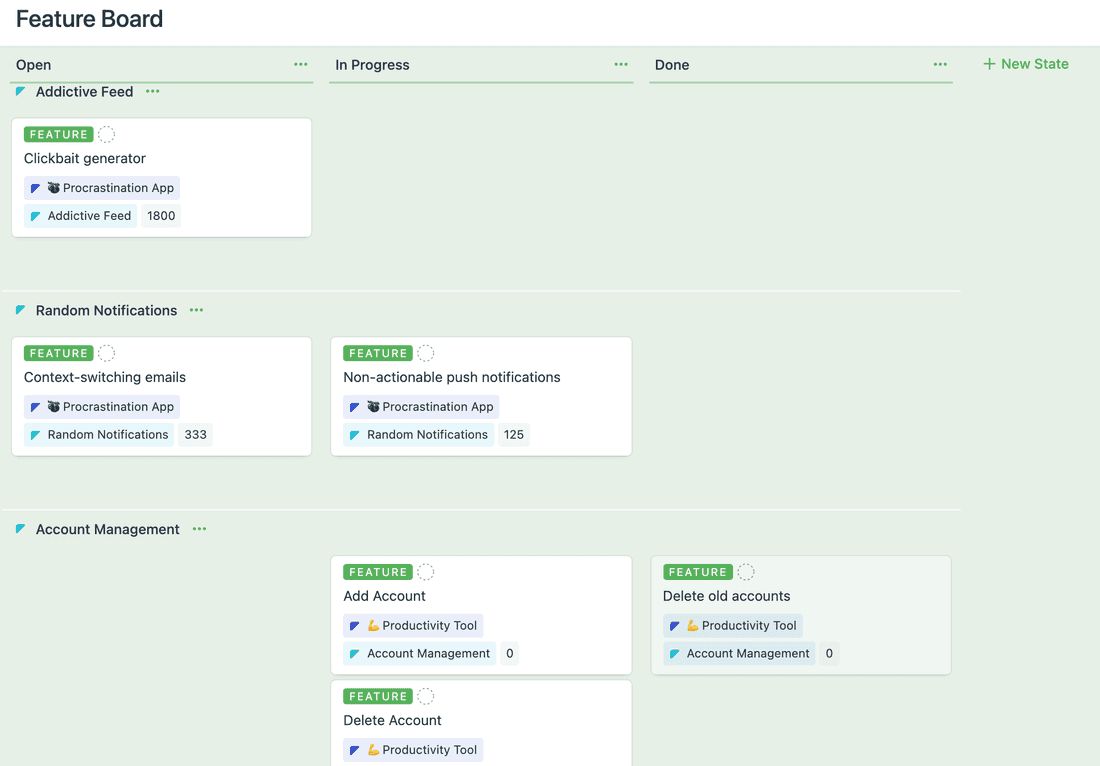
Monday unique Views
Cards View is useful when you work with design assets and other visual stuff.
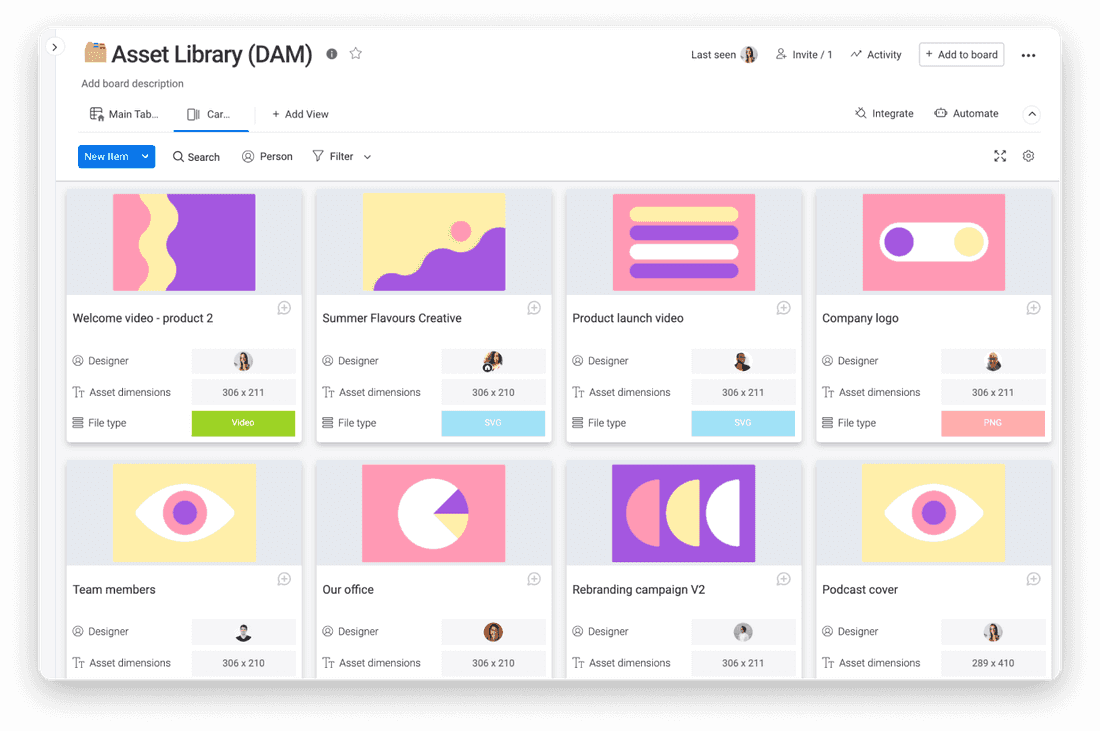
Map is super helpful to Geo visualizations.
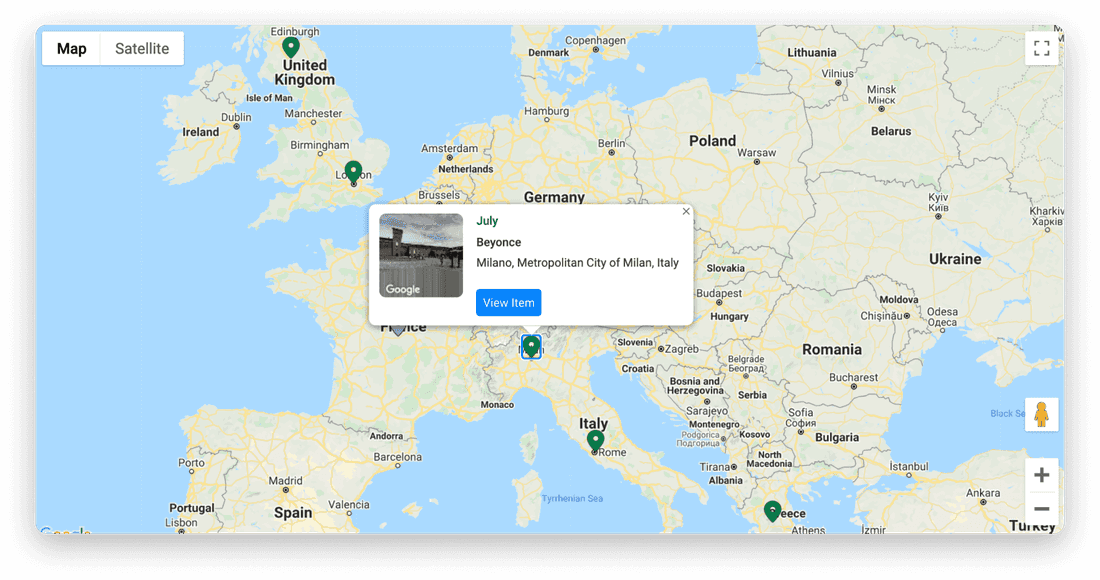
💪 Monday just recently introduced block-based Documents. You can write text and embed Views into Documents. This is a cool feature and Documents work like a charm! One downside is that documents live outside main entities, so you can’t create a Feature and write a specification inside.
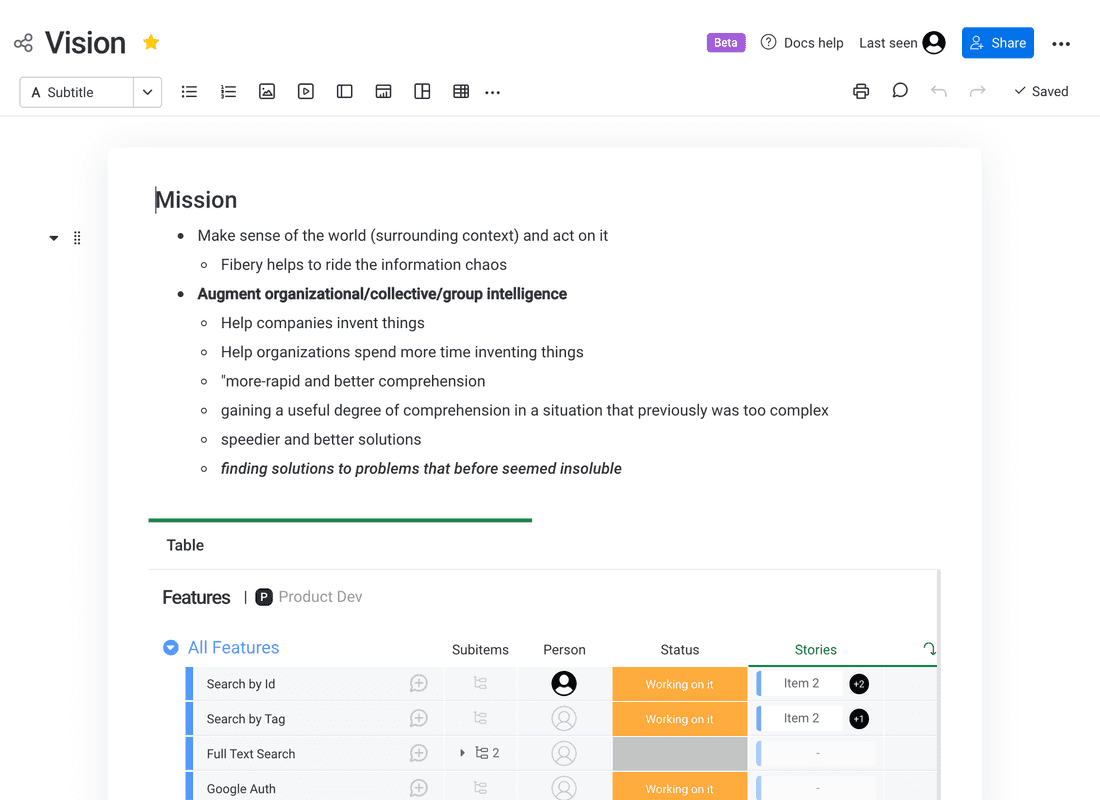
Fibery unique Views
Whiteboard in Fibery is a flexible view to create various diagrams and mind maps.

Hierarchical List visualizes unlimited levels of hierarchy. For example, here we can see a Product Area with all its Features, User Stories, and Bugs.
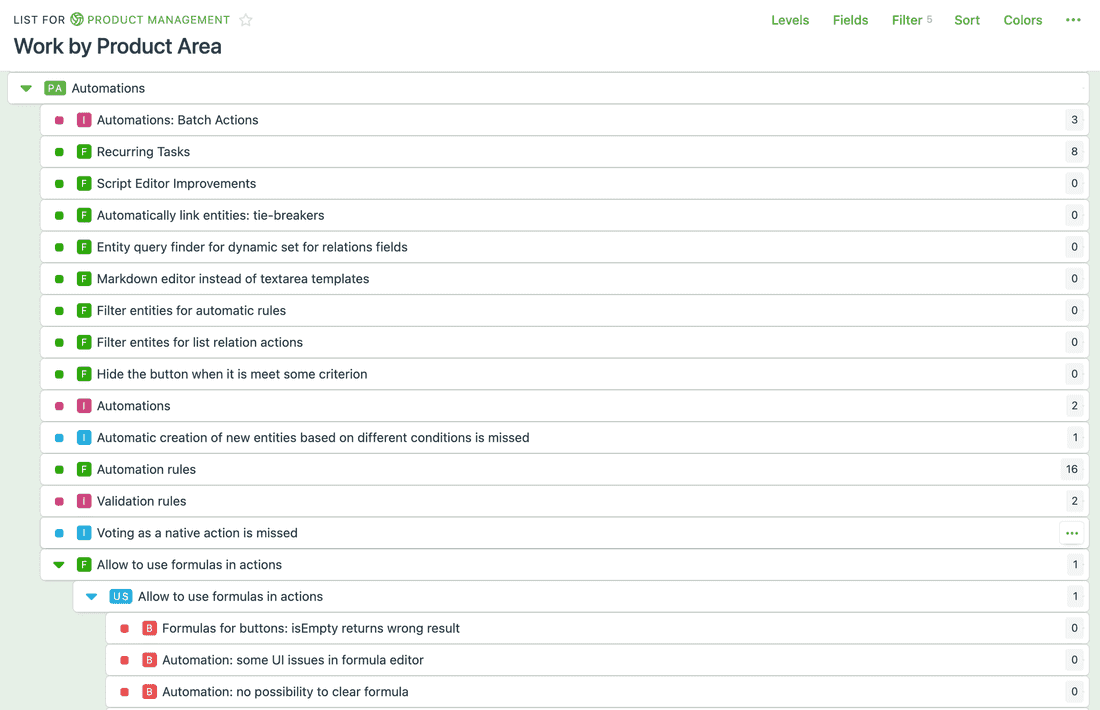
Reports & Charts
💪 Monday has decent Dashboards to visualize various information. There are many widgets, including charts, metrics, etc.
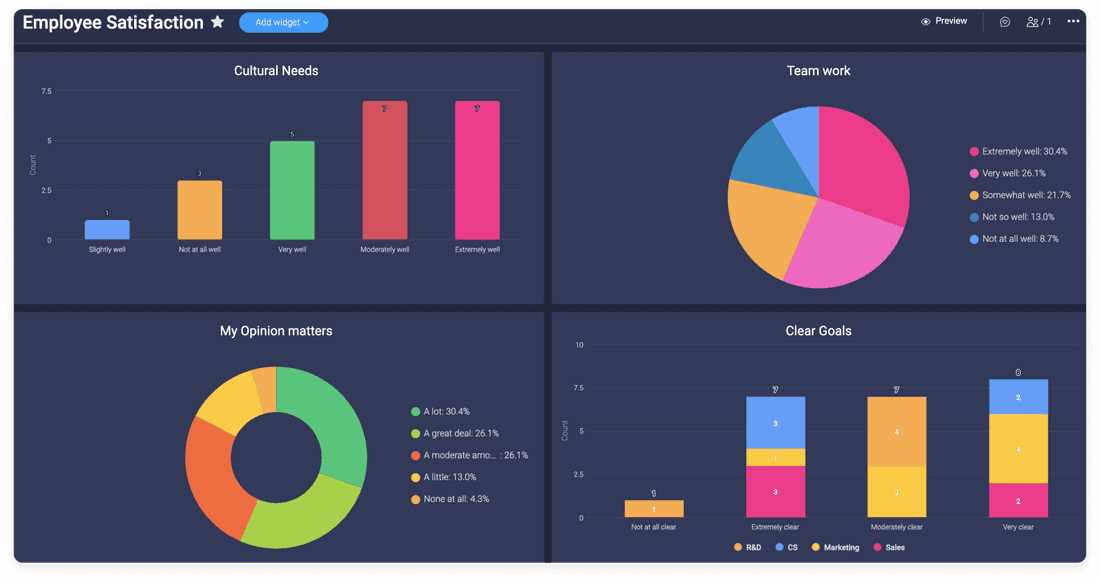
However, charts in Monday are quite basic.
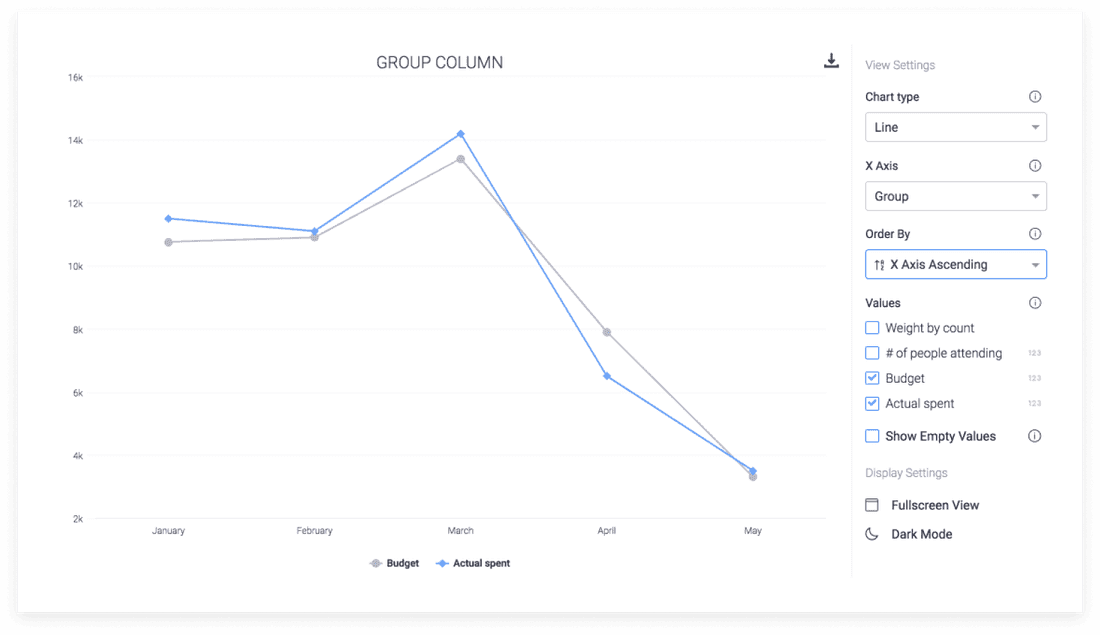
💪 Fibery has very powerful charts with a Tableau-like experience. You can visualize almost anything.

🦐 However, there are no Dashboards in Fibery, and you have to browse charts one by one, and this is not very convenient.
Automations
In Monday automations are great. There are many events and actions you can combine and rules library is nice.
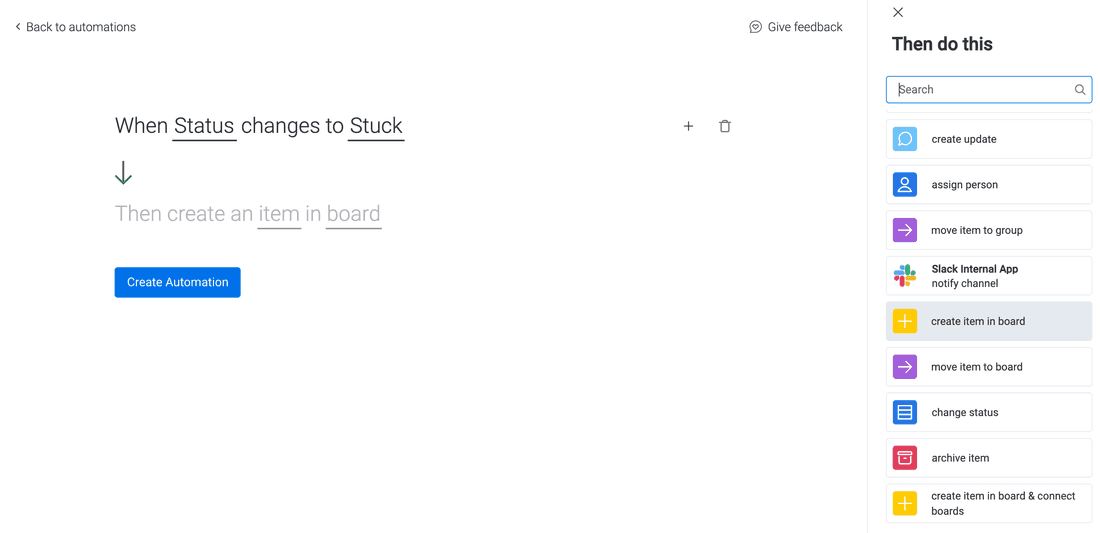
In Fibery you can automate things as well, by adding automatic rules in Databases. Setup is easy as well. However, rules for related entities are much easier in Fibery, because relations are first-class citizens.
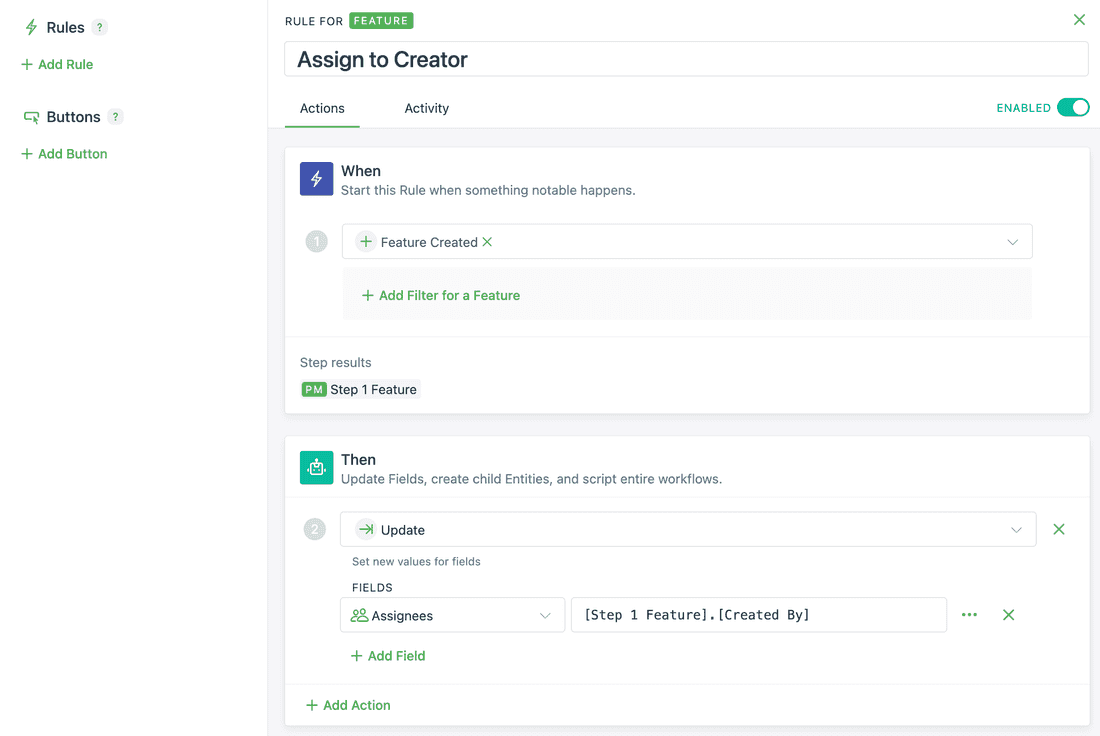
Action Buttons
Fibery and Monday both have Action Buttons, custom actions that you can execute manually whenever you see some entity.
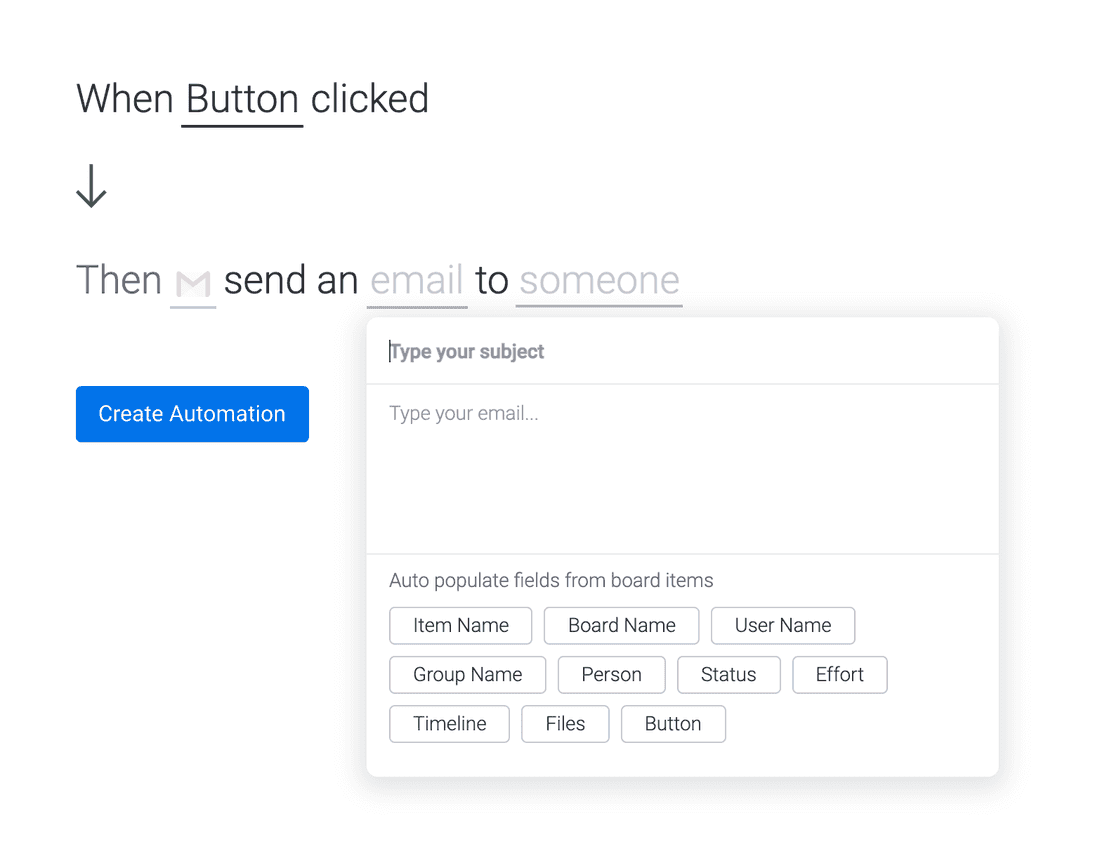
Fibery Action Buttons are powerful as well.
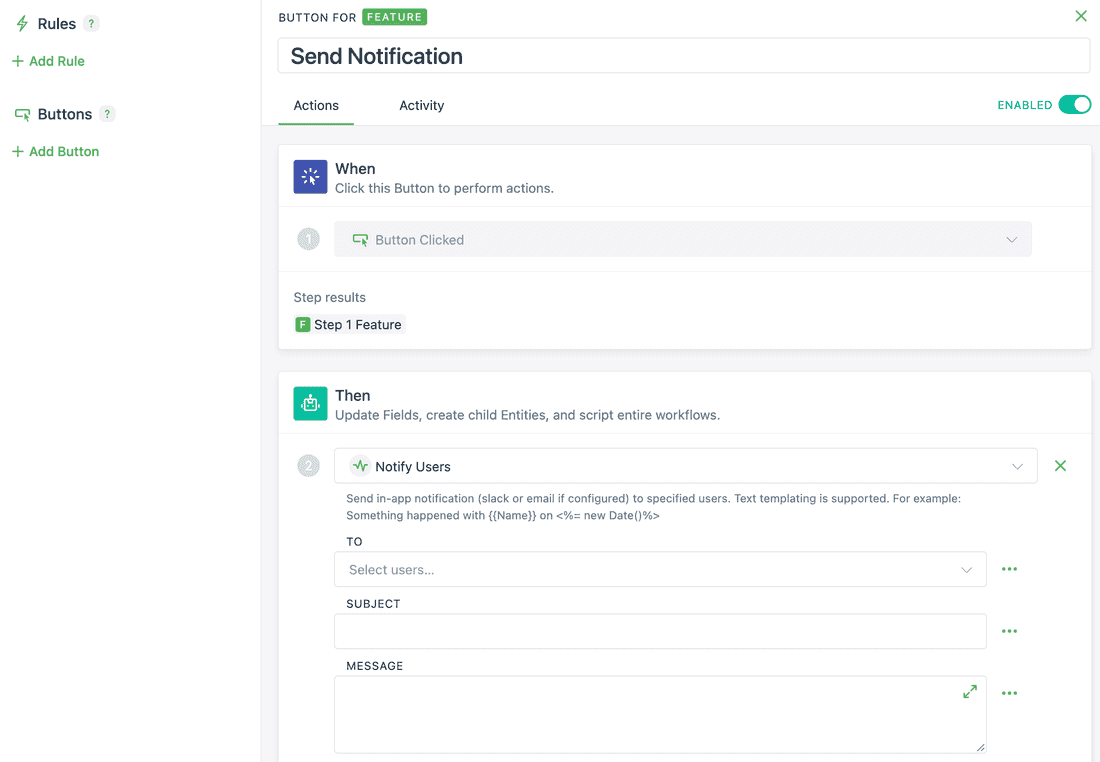
API & Integrations
💪 Monday has about 40 integrations. Overall, it works like internal Zapier, you connect some external App and set rules to communicate with it. For some apps even two-ways sync is possible! I’d say this is one of the most beautiful implementations I’ve ever seen.
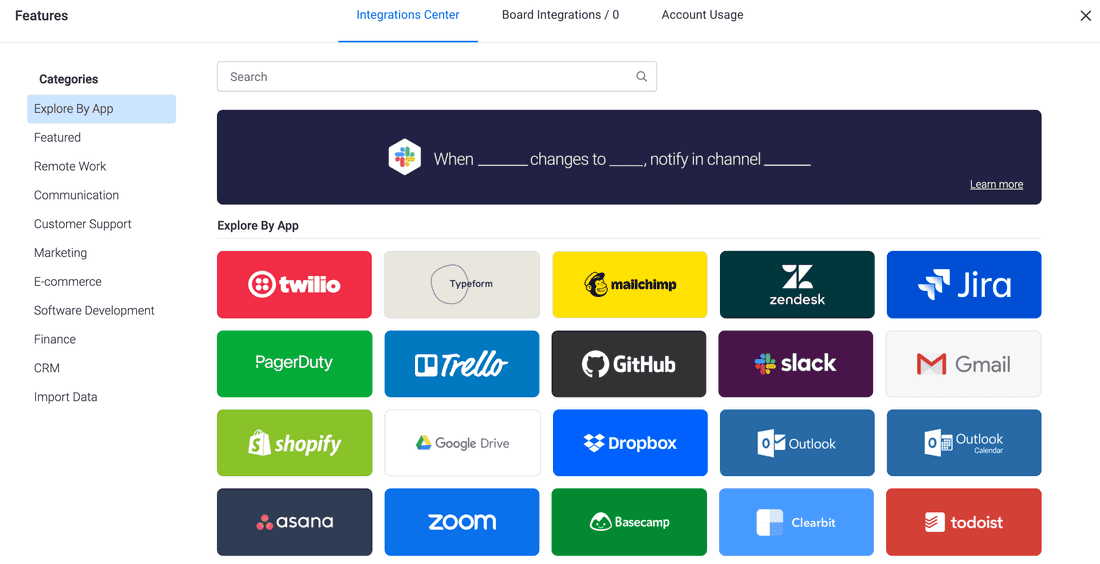
Fibery has a different approach to integrations. Fibery has a flexible domain. Fibery integration app replicates a domain of any external tool and fetches all required data. Then you can connect this data with Fibery entities and use it as usual Fibery data (Create charts, create Views, add formulas, etc.). It’s a very powerful approach since it unfolds many useful cases:
- Calculate real MRR for your Accounts (fetch Invoices from Braintree and link them to Accounts via relations)
- Attach all feedback from Intercom to Features (fetch Intercom chats and use bi-directional links)
- Attach all tasks from Jira to Features (fetch Jira tasks and link them to Features via relations)
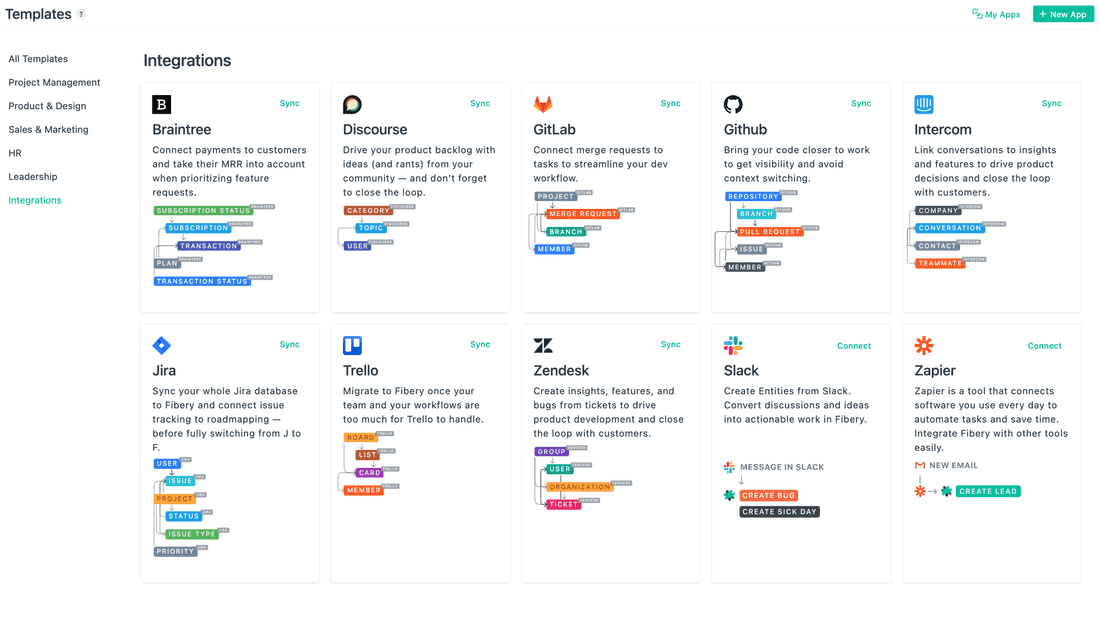
🦐 However, data sync is one-way. You can’t change the status of Jira tasks from Fibery, for example.
Both tools have a good API, but Fibery has GraphQL API on top.
Public sharing
💪 Sharing is quite flexible in Monday. You can share any View or a Document.
In Fibery you can share Documents, entities (like Task, Feature or Project), and Reports. It is not possible to share some Views (like Timeline, or Board).
Summary
☎️ Monday
Monday is a powerful tool that can cover many processes. In my opinion, it’s somewhere between Airtable and ClickUp. Airtable is more database than work management, ClickUp is more work management than a database. Monday is slightly closer to ClickUp, but it covers database cases better.
Monday works nicely for many processes (HR, basic tasks management, etc), but the lack of hierarchies makes it a hard choice for complex processes, like product management. There are many problems here: not very interactive timelines, poor hierarchies, separation of specifications and features, poor card/item representation, lack of feedback aggregation, etc.
Monday is not about text. If you have a text-heavy process, like knowledge accumulation, specifications creation, ideation, feedback management, Monday is not a good choice, since it only has Documents that are not well connected with other things.
🐉 Fibery
Fibery lacks some features in comparison with Monday. Personal productivity is not as efficient. Monday will work better for basic processes
However, Fibery works better for complex processes, like product management. It supports hierarchies better, connects feedback to roadmaps and roadmaps to execution, timeline view has more capabilities, specifications are inside features.
Fibery loves text-heavy processes. Rich text is embedded into all entities and bi-directional links are there. So you can use Fibery to collect feedback, write specifications, etc.
Fibery is a connected platform that loves text, while Monday is not so much.
Fibery
---
💪 Hierarchies are deep and easy
💪 Relations are powerful
🦐 Lack of some productivity features
💪 Whiteboard View
💪 Timeline View allows planning
💪 Hierarchical List
💪 Powerful formulas
💪 Rich edit collaborative field to capture text inside entities
💪 Bi-directional links
💪 Powerful charts
💪 GraphQL API
🦐 Integrations are one-way
🦐 No mobile apps
Monday
---
🦐 Hierarchies are impossible to visualize
🦐 Relations are very basic and incomplete
💪 Many small productivity features
🦐 Limited formulas power
💪 Gantt View
💪 Block-based Documents
💪 Map View
💪 Dashboards
💪 Cool integrations
💪 Flexible sharing
💪 Mobile apps
🦐 Poor support of text-heavy processes
Psst... Wanna try Fibery? 👀
Infinitely flexible product discovery & development platform.
